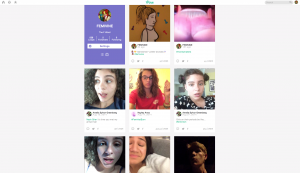Maria and I began working from a case study that examined an online video competition launched by Eli Roth and his digital horror network The Crypt, called #6SecondScare. #6SecondScare was orchestrated through short-form video sharing service, Vine. We’ve since evolved our project, focussing solely on Vine as a platform, though looking closely at dialectical montage, using the Kuleshov effect as a theoretical and visual reference for our explorations. Essentially, our objective was to examine how the theory of dialectical montage is exemplified through Vine. This too has evolved into our Project Four prototype: a Vine account called FEMIVINE, which utilises the theoretical foundations of dialectical montage to convey messages of self-interest. In this case, feminism.
Maria and I have worked exclusively with the platform Vine in our exploration of online video practise. Vine is a user-generated short-form online video sharing service, which emerged alongside other social media platforms such as Facebook, Instagram and Twitter. Maria and I have acquired extensive knowledge about this service, from form and Vine-specific creativity, right through to copyright infringement loopholes.
The evolution of our ideas and the experimental nature of our developments are consequential of the sketching process championed by our tutor, Seth, and award-winning music educator, Eric Booth. Our studio encouraged creative freedom, playful brainstorming and practical ‘excess’, meaning, produce as many sketches as possible sans overthinking and over-analysis. In other words, allow for experimentation and avoid creative trajectories. Our projects (specifically p-3 and p-4) have been predominantly theory-led, but over the course of the studio we have moved away from theory-led research and toward a more exploratory practise-led process. It took me awhile to adopt the exploratory sketching process to inform my projects. I am naturally drawn the theoretical basis, so it is difficult for me to disassociate from well founded principles and, instead, trust my creative instincts. Though I do not regret my decision to begin with theory-led research, because I feel this is a more reliable structure to work from. I would prefer to solidify my theoretical groundings and undertake exploratory investigations inspired by those theories, rather than backpedal and precariously draw theoretical implications after a product is made. That said, I am so grateful to this studio for encouraging me to adopt the sketching process. Now that I am comfortable with this approach, I am certain I will apply this attitude to many other tasks/activities throughout my academic development and, similarly, to my personal and professional endeavours.
The second, most prominent, feature of our studio was presentations. I have presented approximately five times altogether. I recall feeling terrified for my first presentation, and having very little idea as to what was expected of me. By no means have I perfected my presentations, I have, however, acquired a confidence in knowing what kind of informational and aids I should include in my presentations. As well as a more relaxed and comfortable attitude towards presenting my ideas to a class.
The most relevant theoretical component of our studio is the distinction of narrative/non-narrative form. Bordwell and Thompson’s definitions of narrative form and structure informed the majority of our explorations. Bordwell and Thompson four different types of nonnarrative form: rhetorical, categorical, abstract and associational. Our exploration of dialectical montage in Vine relates to Bordwell and Thompson’s definition of ‘associational form’, wherein the juxtaposition of loosely connected images convey an emotion or concept to the audience. The very fact that the images and sounds are juxtaposed makes us look for a connection or association that binds them together. Dialectical montage–our theoretical focus for p-3 and p-4–Montage operates on the principle that the juxtaposition of two shots, and the consequent conflict, allows for abstract concepts to be understood by inference. Essentially, montage is based on the principle that people are hard-wired to make connections by association and create meaning out of what they see.
My most significant ‘breakthrough’ was learning the obvious distinction between traditional and new media. These are areas I intrinsically understand as being different, though I never consciously considered the clear segregation of the two. Eugenia Siapera’s text on the different theoretical perspectives on new media guided my understanding of the synergy of society and technology. Society and technology evolve together. This is an area I would like a greater understanding of, as I have only scratched the surface.
Lastly, the blogging process attributed to this course has been revolutionary for me. I can be forgetful and, similarly, disorganised with archiving research. Having one place to document all of my research, including my assignments, has been a life-saver.
Overall, my studio experience has been remarkably informative. The progress I have made over the semester, foremost, a confidence in sharing my academic judgement, is enormous. Only in retrospect have I acknowledged how much I have gained from this studio: the ability to creatively sketch my ideas, presentation skills, a thorough understanding of narrative form, and intensive knowledge of social media platform, Vine.
Word count: 820



